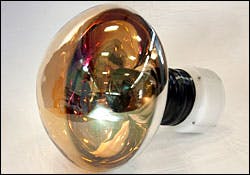Photomultiplier-tube implosion tests help design stronger neutrino detectors
Newport, RI--At a once defunct Navy facility in Rhode Island, scientists from the Brookhaven National Laboratory (Upton, NY) are working on the proposed Long Baseline Neutrino Experiment (LBNE). There, they have set up a death trap for the large photomultiplier tubes (PMTs) that serve as key components of the project's future neutrino detector. Under the stress of 500,000 gallons of pressurized water, the PMTs meet their end in dramatic implosions.
Thousands of PMTs will line two massive detectors in an effort to illuminate the behavior of neutrinos. In its current design, LBNE will send the world's most intense beam of neutrinos about 800 miles underground from Fermi National Accelerator Laboratory in Illinois to a mine in South Dakota. Brookhaven is leading the management, design, and construction of the experiment's two water Cerenkov detectors, each large enough to hold a 20-story building or nearly 37 million gallons of ultrapure water. When a neutrino interacts with the water molecules, it will create light that gets detected by the 50,000 PMTs lining the detector's walls.
Chain reaction
The entire endeavor will require 100,000 of the fragile tubes, which have caused major headaches in the past. "If one tube fails, so will the one next to it, and the one next to it, and so on until there's a full-blown chain reaction," said Rahul Sharma, a mechanical engineer working on LBNE.
In a similar detector at the Super-Kamiokande neutrino experiment in Japan, an implosion of one faulty PMT created a shock wave that destroyed more than half of its closely placed neighbors. By studying the PMTs' demise, BNL scientists hope to find the best possible design for the LBNE version.
"If something similar happened at LBNE, it would be a showstopper for the experiment," Sharma said. "It would take a very long time, and a lot of money, to drain the detector, replace the bulbs, and start again. We want to be sure that even if one of our tubes fails during the experiment, it doesn't take out the rest of the bulbs with it."
Sharma and other members of Brookhaven's LBNE group started their implosion investigations in-house with an item much smaller, and cheaper, than a photomultiplier tube: a light bulb. In a 60 gallon pressurized tank, scientists used a high-speed camera to watch the bulb implode. After similar tests on imitation PMTs and extensive pressure modeling, the group moved on to the real thing.
Working with the Navy
At the end of 2009, BNL physicists started working with staff from the Naval Undersea Warfare Center (NUWC) in Rhode Island to bring a former torpedo-testing facility back to life. The Propulsion Noise Test System, featuring a 50 foot spherical tank, has been shut down 17 years earlier.
Testing began in December. After submerging a PMT in water pressurized to 88 psi (the pressure that will exist in the LBNE detectors), the team punched a small hole through the glass bulb with a hydraulic metal poker, breaking its vacuum. High-speed cameras sequenced the resulting implosion. And sensors placed in the tank recorded the shock wave created from water rushing into the tube's empty space.
Researchers found that for a few microseconds following the start of the implosion, the pressure of the water closest to the tube soars to 800 psi. These results closely match implosion modeling that the Brookhaven scientists performed prior to the tests. "That's a lot of pressure, but it lasts only a few microseconds," said Sharma. "Is it enough to start a wave of implosions in a detector? We will study this."
Now that the scientists have confirmed their models with real data, they are exploring two ways to prevent a catastrophic implosion in the detector. The first option is to make the PMT glass itself stronger. With help from glass experts at Alfred University, the scientists might search for a material strong enough to withstand the impact of a nearby implosion. The second option is to design PMT enclosures that in the case of an implosion would deflect or absorb the shock wave, protecting its intact neighbors.
The current LBNE schedule calls for a final design of the PMT array by 2014.

John Wallace | Senior Technical Editor (1998-2022)
John Wallace was with Laser Focus World for nearly 25 years, retiring in late June 2022. He obtained a bachelor's degree in mechanical engineering and physics at Rutgers University and a master's in optical engineering at the University of Rochester. Before becoming an editor, John worked as an engineer at RCA, Exxon, Eastman Kodak, and GCA Corporation.
